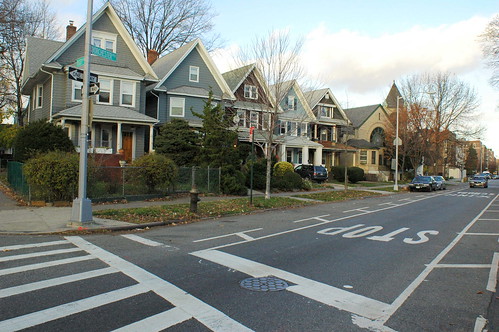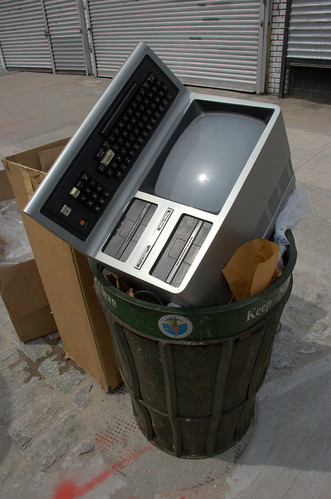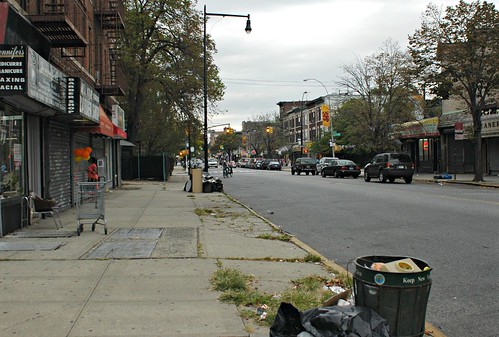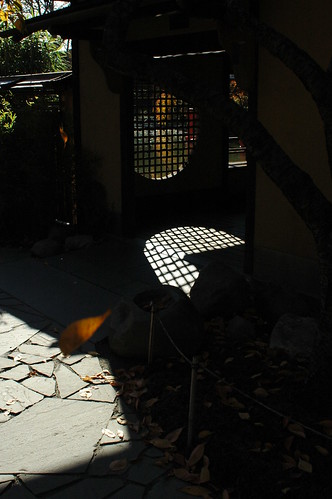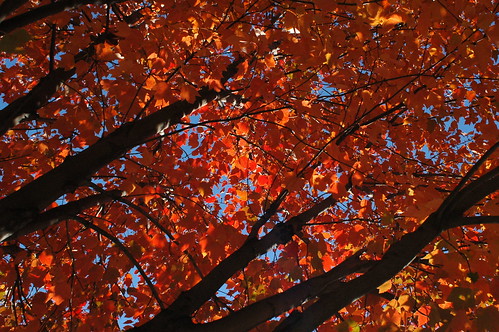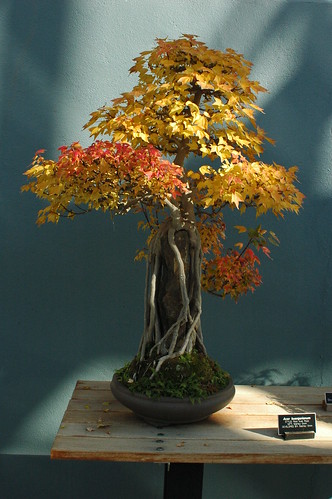The Brooklyn Blogade in the Member’s Room of BBG’s Lab & Admin Building

Earlier today, the Brooklyn Blogade, a semi-regular gathering of Brooklyn bloggers from across Brooklyn, met at the Brooklyn Botanic Garden. We had perfect weather for the outdoor portions of our visit, which included schmoozing in BBG’s open-air Terrace Cafe and a guided tour of some of the Garden. During the indoor session, we had presentations from BBG staff and free-wheeling Q&A about the online face of BBG: where it came from, where it is today, and where it could go.
We had a great turnout, including several faces new to the Blogade. Those attending or represented included:
and, of course, the hosts for today’s event, the Brooklyn Botanic Garden and Flatbush Gardener.
From 11am on, we gradually assembled in the Terrace Cafe. Folks had a chance to get something to eat, sit around, make introductions, chat, and so on. We greeted friends and made new acquaintances.
Shortly after noon, we moved to the Member’s Room, seen in the photo at the top of this post. I briefly explained the agenda for the rest of the day, then turned it over to our hosts from BBG.
Elizabeth Peters, BBG’s Director of Publications, was first up. She provided a brief history of the Garden, from its founding and opening to the public in 1910 and 1911 to the present.

BBG’s centennial is just two years away. BBG hopes to have a new Visitor’s Center ready for that. The new Center will transform the northwest corner of the Garden, where they share a parking lot with the Brooklyn Museum, and open it up to Washington Avenue. This rendering, from BBG’s 2007 Annual Report, depicts how the new Center will appear from the Cherry Walk inside the garden, looking northwest toward the new entrance on Washington Avenue. The Overlook, with its allee of mature Ginkgo trees, is to the left.

Although construction will require permanent removal of four Ginkgos, one will be transplanted elsewhere in the Garden – a project in itself – and the other three will have their lumber put to use in the Visitor’s Center. Test beds for the green roof in the building are already planted out along the Overlook, in roughly the location the building will occupy. We saw these during the guided tour for the Blogade. The roof will be a meadow of what looked to be mostly, if not entirely, native plant species and cultivars.

The Visitor Center will be BBG’s first “green” building and will be part of an unfolding series of future projects, including new gardens and improvements to public entrances. Constructed to meet rigorous Leadership in Energy and Environmental Design (LEED) Green Building certification standards, the Visitor Center will feature such environmental elements as a living roof, use of recycled building materials, passive solar principles, geothermal heating, and bioswales (recessed catchment zones filled with water-loving plants) that will improve storm water management and relieve the burden on the municipal sewer system. It will house an exquisite new garden shop, a much-needed orientation room for tours and classes, an information desk, a dramatic event space, a refreshment bar, and other visitor amenities.
– Capital Projects & Master Site Plan, 2007 Annual Report, Brooklyn Botanic Garden
Dave Allen, BBG’s Web Manager, spoke next. The integrity of the information available through BBG is an important aspect of BBG’s educational mission. Dave spoke of the challenges to opening up BBG’s online presence, while retaining its “authoritative” voice.

We’re just seeing the beginnings of BBG’s online transformation, one that will parallel transformation on the grounds. They experimented two years ago, during the historic bloom of BBG’s Titan Arum, “Baby.” They published the online journal of Allesandro Chiari, BBG’s Director of Propagation, as he tracked the growth, peak, and death of the bloom. They even published some visitor content on their Web site: some of my photos of “Baby” on my final visit, just after peak bloom, and in the early stages of decline before collapse.
BBG’s current Web site is static pages, “authoritative” in content and tone, and closed to more personal observations. Development is already underway on BBG’s next generation Web site – call it “BBG.org 2.0” – which will incorporate more dynamic content, personal observations of BBG staff, and more.
Following the lively discussion about BBG and its online efforts, we did the round-robin “Shout-out” where each of us introduced ourselves and our blogs, and had a chance to share our interests.

After the Shout-out, there was time for coffee, cookies, and more schmoozing before our tour guides joined us and took us out onto the grounds.
Our primary guide, Christina, was a good sport. Not only did she have three BBG staffers and another guide on her tour, there was a past BBG tour guide, and a pedantic garden blogger to contend with. Nevertheless, the tour was enjoyed by all, and I hope Christina was able to tolerate our company as much as we enjoyed hers.

Here are the Blogadiers at the Viewing Pavilion in the Japanese Garden …

… in the Cranford Rose Garden …

… and the Osborne Garden …

… and viewing the knot garden in BBG’s Herb Garden. This may be the last year for the knot garden. This is right where the new Visitor’s Center and entrance will be located. The entire Herb Garden will be recreated near the southern end of the garden, along Flatbush Avenue.

Related Content
Flickr photo set
Announcement post for today’s Blogade
Other Brooklyn Blogade posts
Links
Brooklynometry
Creative Times
Curly Comedy
The Luna Park Gazette
Prospect: A Year in the Park
Brooklyn Botanic Garden:


